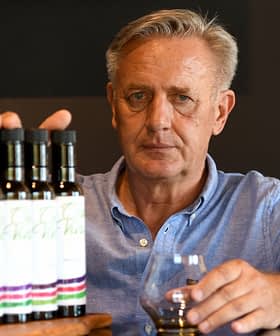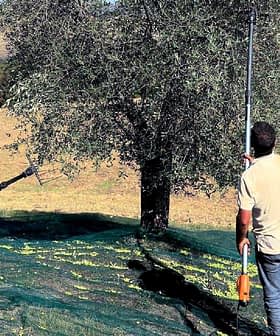How an Experimental Farm in Japan Gave Rise to Award-Winning Olive Oil
What started as a land restoration project has transformed into an award-winning extra virgin olive oil-producing operation on the southern Japanese island of Kyushu.
A land restoration project lies behind one of Japan’s best extra virgin olive oils.
Kunisaki QLiVE Garden, located on Kyushu, one of the southernmost of Japan’s main islands, earned a Silver Award at the 2023 NYIOOC World Olive Oil Competition.
Kyushu is well known for its green mountainous landscape, hot springs, Japan’s most active volcanos, and its mild climate. On the northern Kunisaki peninsula, in the Oita prefecture, olive farming gained momentum in the last 10 years.
See Also:Producer Profiles“Kunisaki city faces the Setonai Sea. It is a warm area with lots of sunshine,” Takahiro Ohno, general manager of the olive business promotion office of the local Kyusetsu AQUA Corporation, told Olive Oil Times.
“The climate here is mostly similar to the Mediterranean, making it suitable for olive cultivation,” he added.
The project began in 2016 as an initiative of Ohno’s company, a waste management firm operating in a neighboring prefecture.
“The company maintains and manages water and sewage systems. To contribute to the local community, it decided to venture into agriculture in Kunisaki,” Ohno said. “At the time, thousands of olive saplings were planted on an area of approximately 15 hectares.”

The project was named after its land and community restoration goals. “The QLiVE name was created by applying a ‘q’ to the word olive so that it could stand for ‘live’ in good quality,” Ohno said.
In the following years, the growing interest in extra virgin olive oil and the experience developed by the company’s staff allowed for a further expansion of the groves.
Today, Kunisaki’s approximately 4,000 olive trees cover 38 hectares, which the company said makes it the largest olive farm in Japan.
QLiVE’s winning olive oil at the NYIOOC was its Yumeshizuku blend, which the panel of judges said had the tasting sensation of herbs, chicory, cinnamon and ripe notes.
“It is an extra virgin olive oil characterized by very low acidity, which does not reach 0.1 percent,” Ohno added. “Its qualities come from blending the olives of cultivars of Italian and Spanish origin. The key to its flavors is the perfect balance of its bitter and spicy notes.”
Frantoio, Leccino, Pendolino, Nevadillo and Manzanillo are among the many olive varieties grown on the farm for oil production. Meanwhile, two Italian varieties, Taggiasca and Santa Caterina, are primarily dedicated to producing table olives.

The company can produce different extra virgin olive oil blends from the same varieties by changing the harvest time. For example, Yumeshizuku Hayazumi is a robust extra virgin olive oil made from early-harvest olives.
“The company also produces Cleave oil, which blends wheat extracts with olive oil made with Italian varieties, as well as flavored oils made by kneading Italian olives and fruits together,” Ohno underlined.
Along with extra virgin olive oil and other blended oils, the company also produces olive leaf powder and olive-based skincare products.
Like in other olive-growing regions of Japan, coping with high levels of rainfall is one of the challenges Kunisaki QLiVE Garden faces.
Abundant precipitation during Japan’s monsoon season often interrupts the harvest, while extreme weather events occasionally create significant obstacles.
“Last year, about 800 trees fell due to typhoon damage. Recently, there has been a lot of rain and wind,” Ohno said.
In Oita prefecture, significant amounts of rainfall are traditionally reported between April and October. In months such as June, rainfall can exceed 350 millimeters.
By comparison, average precipitation barely exceeds 50 millimeters at the same time of year in Jaén, Spain, the world’s largest olive oil-producing region.
“To secure the best possible outcome in olive growing, our cultivation staff regularly attends technical training sessions,” Ohno said.
He added how the farm follows best practices to take care of the trees, including constant efforts to reduce the amount of pesticides and herbicides used.
“We also research pruning techniques,” said Ohno, hinting at the better results in terms of production and health of the trees that derive from constantly upgrading the pruning operations.
“The farm’s staff routinely visits farms that are engaged in advanced cultivation projects so that they can constantly improve their knowledge about the latest cultivation techniques,” Ohno said.
Another challenge the company experiences is the shortage of workers. “Given the location, which is not easy to access, it is difficult to secure a labor force,” Ohno said.
Along with following best practices on the farm, Ohno said the company’s modern mill plays a significant role in its ability to produce high-quality extra virgin olive oil.

“Such machinery allows us to process the olives within a maximum of 12 hours of harvesting, which is also one of the reasons high-quality ensues as well as the lowest degree of oxidation,” he said.
“Our olives are hand-picked, and fruits are sorted one by one, as only the good ones are identified and destined for our extra virgin olive oil production,” Ohno added.
Kunisaki QLiVE Garden is also actively engaged in spreading a culture of olive oil quality among Japanese consumers.
“What we see happening many times is that consumers tend to compare domestic high-quality extra virgin olive oils to cheaper and lower quality olive oils imported from abroad,” Ohno said.
The price factor comes into play for many consumers, at least until they are tempted by a tasting session.
“It all changes with tasting,” he said. “When I ask customers to taste our olive oils, they are surprised at how delicious those are.”
Ohno combines the tasting experience with explaining olive oil’s health benefits and organoleptic qualities. “[Then] they are convinced and buy it,” he said.
“We do reach out to the consumers in all kinds of useful public events so that we can explain the differences among the grades of olive oil,” Ohno added.
“Customers who become intrigued by olive oil and how it is produced sometimes come to our farm to visit us,” Ohno explained, hinting at the goal of the company to open an olive tourist farm within the next five years.
“Our visitors are amazed by the size of our farm and by the view of the ocean in the distance,” he concluded.
Share this article









